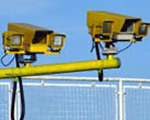 Go to main content
Go to main content
Archive Website of the UK government
Please note that this website has a UK government accesskeys system.
Main menu
Page menu
Travel and transport

Cameras on motorways and trunk roads

As you drive on motorways and trunk roads in England, your car may be photographed by a variety of cameras and filmed by CCTV. Find out about the different types of cameras, what they are used for and what happens to the images.
Cameras for monitoring traffic flow
These cameras are used to gather information about how traffic is moving. The National and Regional Traffic Control Centres in England use this information to respond quickly to incidents and congestion and keep traffic moving.

CCTV
Highways Agency CCTV cameras monitor traffic flow at key points on the network 24 hours a day, every day.
The information is used to:
- monitor network use
- set up diversion routes with the police
- protect the network against vandalism/misuse
- ensure the safety of vulnerable motorists and monitor callers on emergency roadside phones
- provide traffic information, including live feeds from CCTV cameras, to the general public
The police may request the images for law enforcement.
The images that are transmitted on the Highways Agency website meet current data protection standards. They do not show personal details, like identity or car number plates.

Automatic number plate recognition cameras
These cameras can be spotted by their bright green casings and are currently at around 500 sites across England. They work in pairs to help the National Traffic Control Centre (NTCC) monitor journey times. One camera photographs the number plate as your car passes it. The next camera recognises the plate and notes the time it has taken for your car to travel between the two.
The data is automatically collated and sent to the NTCC every five minutes. The actual number plates are not recorded and are never seen by NTCC staff.
Safety (speed) cameras
These cameras are set up to ensure people do not break the speed limits. Usually the information is processed by local safety camera partnerships, local authorities, the police and the courts. If you are caught speeding on these cameras the police will send you a 'Notice of intended prosecution'.
You can find more information about the rules for safety cameras and what happens if you are caught speeding by following the link below.

Average speed cameras
These measure speed between two points to make sure drivers are not breaking the average speed limit. They are often set up near major roadworks where temporary speed limits are in place.

Spot speed safety cameras
These cameras take a speed reading of vehicles as they pass a single point. They are often set up near major roadworks or at points on the network where there is a history of accidents.

Digital enforcement cameras
Digital enforcement cameras are mostly used to enforce variable speed limits that are shown on overhead signs on certain motorways. These speed limits change in response to traffic conditions. They improve traffic flow and journey times if drivers stick to them. See 'Managing motorway congestion' for more details.
 Facebook
Facebook Twitter
Twitter StumbleUpon
StumbleUpon Delicious
Delicious Reddit
Reddit